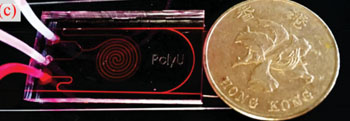Microfluidic Chip Developed For Ultrasensitive Glucose Detection
By LabMedica International staff writers
Posted on 18 May 2016
Highly sensitive and rapid detection of blood glucose is a diagnostic necessity in medicine as, for instance, lack of insulin and too much blood sugar are two main causes of diabetes, both of which can be detected by measuring blood glucose.Posted on 18 May 2016
Fiber optics and microfluidics have been used to develop a cheap, ultra-sensitive lab-on-a-chip device that can quickly measure glucose in just a drop of sweat. The technology behind it belongs to a new field called "optofluidics" that brings together photonic sensing (using the properties of light to detect chemicals) and microfluidics (precise control of tiny amounts of fluid along microchannels).

Image: The lab-on-a-chip device integrates a fiber optic biosensor with a microfluidic chip and detects glucose levels from droplets of sweat. It is shown here next to a Hong Kong dollar, which is the same size as the USD coin (Photo courtesy of Dr. A. Ping Zhang).
Scientists at the Hong Kong Polytechnic University (Kowloon, Hong Kong SAR, China) and their colleagues combined a new fiber optic biosensor with a microfluidic chip to create an interference-free optofluidic device for ultra-sensitive detection of glucose levels. The fiber optic sensor they created is very sensitive to changes in the refractive index of the material that surrounds it. To transform it into a glucose monitor, the team used a film of glucose oxidase as a sensing material as it reacts with glucose in solution.
To both support the sensing film and further enhance the signal, the team incorporated layers of two other materials - polyethylenimine (PEI) and polyacrylic acid (PAA), into the sensor. The result was several layers of PEI/PAA, with a top layer of glucose oxidase that was then embedded in the microchannel of the chip. After running several tests, the investigators found the fiber optic sensor was very sensitive on its own and can detect glucose oxidase concentrations as low as 1 nM, but after they integrated it into the microfluidic chip, the sensor's performance remarkably further improved. The sensor improved not only in detection range, but also in response time, which shortened from six minutes to 70 seconds.
A. Ping Zhang, PhD, an Assistant Professor and co-author of the study said, “Photonic approaches are seen as one of the most promising techniques for ultra-sensitive sensing, and when you integrate photonics with the tiny platform that microfluidic chips offer, you can make a small lab-on-a-chip analysis system for fast and reliable results.” The study was published on April 28, 2016, in the journal Biomedical Optics Express.
Related Links:
Hong Kong Polytechnic University







 assay.jpg)





